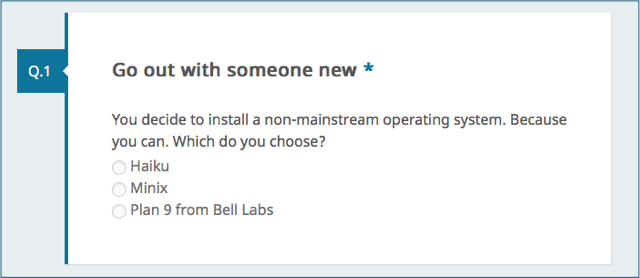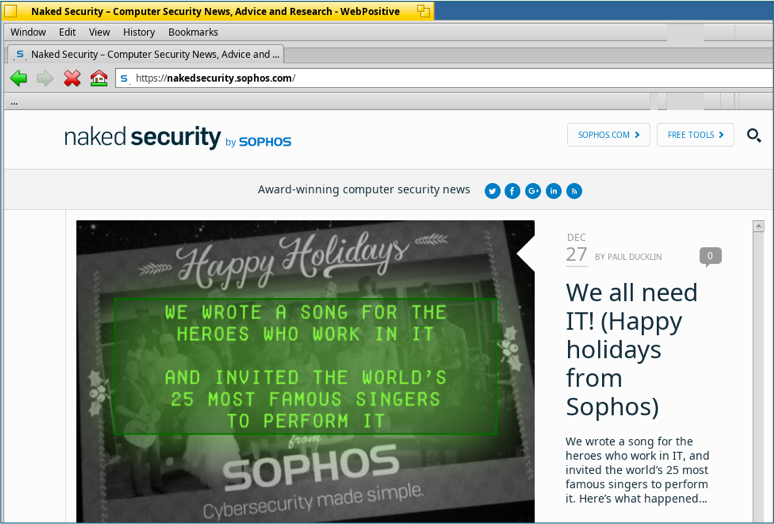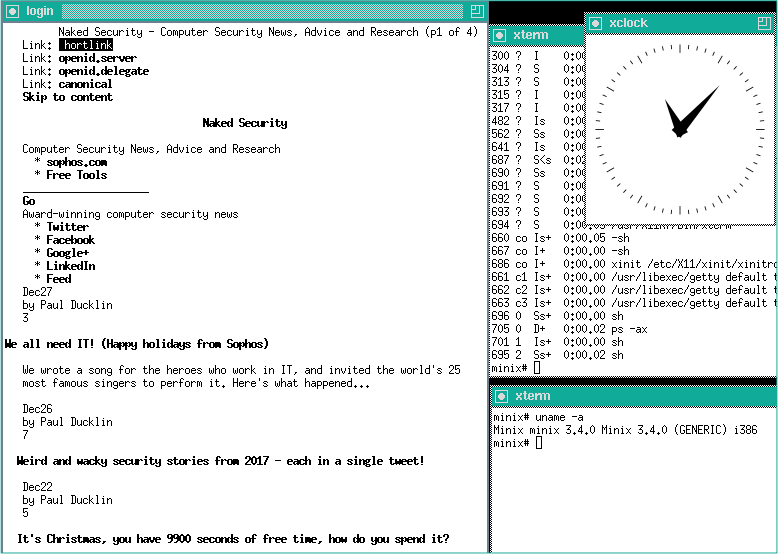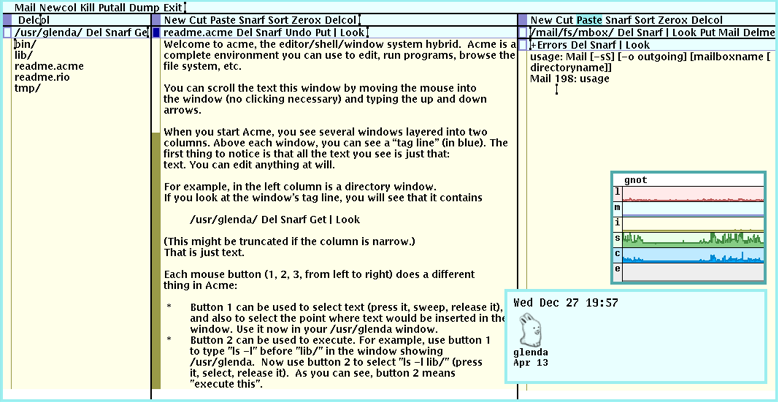Just before Christmas, we put together a holiday-fun quiz to find out what sort of techno-geeky diversions you’d like to lose yourself in, assuming that [a] you have some time off work and [b] you have some online time to spare.
There are three suggestions in the quiz:
- Install a non-mainstream operating system. Because you can.
- Fool around with software you used to love. No one will know.
- Rewrite a well-known algorithm from scratch. Prove you can still code.
But what about the answers?
We pre-selected three answers for each question, and we asked you to choose your favourite from our suggestions.
So we thought we’d review the questions over the course of this week to encourage you to take part in the quiz if you haven’t already. (Actually, given that it’s just for fun, please vote again if you change your mind – that’s fine with us.)
Today, we’re going to look at Q1:

You decide to install a non-mainstream operating system. Because you can. Which do you choose?
Haiku
Minix
Plan 9 from Bell Labs
This question isn’t a joke – all the choices above are real operating systems you can download and try today.
They’re somewhat off the beaten track for most people, though.

Haiku describes itself as “an open-source operating system that specifically targets personal computing. Inspired by the BeOS, Haiku is fast, simple to use, easy to learn and yet very powerful.”
There’s hasn’t been an official version, however, since the Alpha 4 release on November 2012. (Even the apology about the age of the release is out of date, saying “Alpha 4 is now almost 5 years old.”)
So, we went for the latest nightly build, currently haiku-nightly-hrev51712, and we went old-school with the 32-bit version on the grounds that it’s still binary compatible with the long-defunct 32-bit BeOS product from the 1990s.
I remember BeOS fondly, because it was, well, it was cool.
BeOS supported all sorts of multimedia stuff smoothly; you didn’t have to spend hours hacking around with X11 configuration files; there was no time-consuming cross-your-fingers-twice configure-and-make stage; and it had a consistent, clean, reliable window manager that looked superb.
But it was wacky, too: I once did a test intall and everything worked – my network card, the graphics card that was a science project to use under Linux, everything, except the keyboard. Go figure.
Well, no such trouble with the Haiku nightly build – in a VirtualBox VM, it took no more than a few seconds to get a live desktop booted and running with the Naked Security website loaded in the WebPositive browser:

Just like the 1990s, when BeOS was around, the speed was astonishing, lagginess was non-existent, the graphics rendering crisp, and the look surprisingly contemporary. (That’s one way of saying that BeOS was ahead of its time.)
We won’t make any recommendations beyond that, however: we couldn’t figure out how to view the TLS certificate of the website you just connected to, or to check the ciphers supported and used by the browser, so we have no idea how safe you’re likely to be using it.
Nevertheless, it’s worth trying out Haiku just to feel how fast software can be if it really tries.

Our next experiment was Minix, a venerable, free operating system that was not only the inspiration for Linux but also the starting point for Linus Torvalds to get a running system on which to begin development.
Linux, however, ended up very much unlike Minix, and much more like every other mainstream operating system on the market today.
In Linux, user programs run outside the kernel, in what’s known as userland, so they can be regulated pretty closely, but the kernel itself is a vast, sprawling underground edifice that houses all the low-level code – what’s known as a monolithic kernel.
Minix comes from a different starting point: it’s a microkernel, where the privileged code in the kernel itself is kept to a minimum and as much code as possible, including the low-level drivers that control the hardware itself, runs in userland.
The theory is simple: start with the goals of security and maintainability, and worry about performance later.
That makes Minix is a fantastic learning tool, and worth trying out if you haven’t done so already.
Like Haiku, Minix releases are something of a rarity, with the most recent official version being 3.3.0 from November 2014.
We wanted something more recent, so we used the 3.4.0rc6 snapshot from May 2017; this includes a basic X Window System so you can fire up a graphical interface right away.

Yes, that’s twm, short for Tom’s Window Manager, with its default apps: three xterms and an xclock.
Welcome to 1987, complete with X started as root and a bunch of root terminals open by default – for all the caution in its design, the Minix installer advises you to set everything up with a root login and then leaves you to get security right later on.
Ironically, the most recent Firefox file we could find in the official online package repository was 49.0, and that turned out to be the language files only, not the browser itself.
We decided to used the venerable text-mode browser Lynx instead, but the version offered to us didn’t seem to speak a recent enough dialect of TLS, so we tried links, another text-mode browser, as you can see above.
If you get any further than this (a recent Firefox would be nice to see), do let us know in the comments.

And that brings us to Plan 9 from Bell Labs.
Named after the cult 1950s science fiction movie Plan 9 from Outer Space – a strange namesake for a software product to choose, given than the movie’s fame comes from its reputation as the worst film ever made.
Amusingly, Plan 9’s mascot is Glenda, named after the movie Glen or Glenda, an early 1950s film about transvestism from the same director, Ed Woods. (By some accounts, Glen or Glenda was even worse than Plan 9 from Outer Space.)
Plan 9 was a research project at Bell Labs that can be considered decades ahead of its time: everything in the operating system is treated like a file, including devices, traditional files, processes, network connections and more.

Instead of different naming conventions and programming interfaces for local and remote commands, local and network-based files, local and distributed computing jobs…
…there was one input/output protocol to rule them all, 9P.
Where Unix has the cat command to dump data out of files, but needs a completely different command called netcat to shovel data across the network, Plan 9 doesn’t.
Whether a file is moving along a disk cable, across a network link or between two processes in memory (even two processes on different computers), in Plan 9 you can use the same command everywhere.
Plan 9 never really emerged from the research world into real life – the project didn’t survive the enforced breakup of US telecommunications provider AT&T, of which Bell Labs was a part.
What next?
Why not take our quiz now – it’s anonymous, and we think it’s fun.
https://sophoslabs.polldaddy.com/s/christmas-vacation-2018-cool-geek-stuff

Mahhn
” its reputation as the worst film ever made.” I’m partial to the “Blair witch project” being the worst movie.
You make me feel like a total newbie with those questions :) I was not familiar with them at all. That Plan9 and minix sound like they would be good OS for IoT devices.
Paul Ducklin
Funny you should say that… Minix, it turns out, is used at the heart of Intel’s low-level Management Engine firmware, built into many modern motherboards.
Bugs in the IME core have caused concern and controversy recently:
https://nakedsecurity.sophos.com/2017/11/23/worries-over-intels-mangement-engine-grow-after-new-flaws-found/
ejhonda
I sat thru “Plan 9 From Outer Space” at college as part of a “Canned Film Festival”. It definitely earned its reputation – if it wasn’t for some drunk guy running up on stage and miming “Rocky Horror”-style it would have been unbearable. “Blair Witch Project”, however, is a fantastic movie for its impact vs. its simplicity.
In the OS world, I’d say the equivalent to the movie “Plan 9” would be IBM’s OS/2 – that was a terrible piece of work.
Tony Gore
I remember BeOS too – we bought a copy in Fry’s and brought it back. It was a really great OS for its time. And I remember Minix – it was one of the OS’s that we could port to the transputer because of its minimalism and simplicity and open source code – rare at the time. I had not heard of Plan9 but it sounds like some of the fundamentals of it are what people have spent lots of time recently trying to figure out how to do for Exascale machines. Personally, I still think that Occam was one of the best languages for embedded systems – you didn’t need a mega-OS in order to get most things done. One of the interesting things about it was that, in my experience, hardware engineers found it easy to use, because the channel/process model was akin to how we build hardware, but software engineers found it much harder without OS calls to provide high level facilities.
Paul Ducklin
Pity about the T9000. Too little, too late, last one out turn off the lights. I often wonder what might have happened if Inmos had gone into the 1990s simply churning out faster and faster T8s at lower and lower prices with lower and lower power consumption, so that buying a 64-transputer compute box would have been no harder than buying a laptop to plug in into.
mr. waddlesplash (@waddlesplash)
Hey, thanks for the mention of Haiku! … but we’re just called “Haiku” though, not “HaikuOS” (there’s a squatter on haiku.org and they won’t sell for a reasonable price…)
Paul Ducklin
Should be fixed everywhere now (everywhere that’s still editable, I mean, so not in tweets that have already gone out and so forth), including in the quiz pages.
Your domain name (and Google’s frequent use of “Haiku OS” in search results) threw me a bit. Mind you, given that I included your logo, I guess I should have twigged that the “OS” bit existed only in my imagination :-)
j karna
Qubes should have been included. I use it and it is streets ahead of the Linux flavors and Windows.
Paul Ducklin
Qubes isn’t quite what we were looking for here – the thing with Qubes is that it exists for running what you call “the Linux flavours and Windows”, rather that replacing them, using a special variant of the Xen hypervisor.
The operating systems we’ve suggested here are entirely different – you don’t run Linux on top of Haiku, for example, like you might run Whonix on top of Qubes. Haiku *is* the operating system, top to bottom, from boot sector to window manager.
So, although it calls itself “Qubes OS”, you still need an OS to go with it. As Qubes’s own website points out, “Qubes brings to your personal computer the security of the Xen hypervisor, the same software relied on by many major hosting providers to isolate websites and services from each other,” on top of which it claims to bring you “operating system freedom – can’t decide which Linux distribution you prefer? Still need that one Windows program for work? With Qubes, you’re not limited to just one OS.”
Plus, Qubes is a probably a bit too serious for holiday fun – heck, it’s what Ed Snowden uses.
n2kra
RISC OS For the Raspberry Pi…
Geoff Potter
So why not a British OS? Riscos is still being developed (two flavours),. There are several standalone machines, as including versions for Raspberry Pi. And useful software is still being developed. Try Virtual Acorn where you can get the latest version along with loads of software for £75. My RiscPC is over 23 years old, and is used on a daily basis. Only thing I’ve changed was the processor about 20 years ago, and I added another hard disc 15 years ago.
Paul Ducklin
Well, we were proposing a 9900-second experiment in the nerdcave (or in the kitchen while waiting for the turkey to roast), just for fun, so we went for OSes that can run natively on Intel PCS or virtual machines…if you’ve got an ARM handy, or an ARM emulator (QEMU should do the trick), you could indeed try RISC OS.
(On a point of order, ARM got sold off recently, so the British connection is a bit thin these days.)
geoffpotter
ARM is not involved in Riscos in any way. Riscos is developed by Virtual Acorn and Rool, both very English companies.
Paul Ducklin
Point taken.
sdmikef
Wow. Never thought anyone would ever mention Leisure Suit Larry again in my lifetime. Loved that game. Wow.
David
You chose some very Linux-y ones. Why not go all-out weird, though? ReactOS, PickOS, THEOS, eComStation, Syllable, or DOS. Remember DOS?
Paul Ducklin
Linuxy? Linuxy!? LINUXY!!! None of the ones listed are remotely “Linuxy”, at least IMO… BeOS was implemented from scratch in C++ precisely to be different from Linux; Minix and Plan 9 predated it by years and so Linux may be a bit like them, by influence, but not the other way around :-) (Ever wondered how Linux came up with /proc, using a file-based API for processes?)
Pick, eh? That’s a blast from the past. And THEOS – I used that back when it was still OASIS. It had some cool features, but there was just never enough memory left over after the OS and the runtime was loaded.
Uru-Forged
You forgot #4 Paul:
Install a Sophos antivirus that has all the text in Klingon!!
Yes, Sophos did that long ago & yes I still have the .exe. haha!